PART 24
AEC POLYGONSContents:
AEC Polygon - Access ---- Adding AEC Polygons ---- Modifying AEC Polygons ---- AEC Polygon Styles ---- AEC Polygon Display Properties ---- AEC Polygon - Customizing and Tricks
|
PART 24 AEC POLYGONSContents: AEC Polygon - Access ---- Adding AEC Polygons ---- Modifying AEC Polygons ---- AEC Polygon Styles ---- AEC Polygon Display Properties ---- AEC Polygon - Customizing and Tricks |
| 1AEC Polygon - Access | .1-24 POLYGONS | ||||||||
| AEC Polygon toolbar How do I get this toolbar? - Note: I did not add this toolbar to the PowerSTRIP menu since I did not find these tools very useful. You can also acquire access to some of these commands from the Alternate Document pull-down menu. From the Alternate Document pull-down menu, pick AEC Polygon > and cascade to their respective commands. |
 |
||||||||
| AEC Polygon pull-down menu The AEC Polygon tools are a derivative of the Area tools. For anyone familiar with AutoCAD's Region command, you can think of AEC Polygons as "tricked out" Regions that have ADT's display and organizational features.
If you are a person who uses Plines with Width, this may be a new opportunity to control that Width through a Style rather than through the Pedit command. The problem with AEC Polygons, though, is that they have to be polygons so you cannot apply this new Width option to things like contour lines. Please feel free to e-mail me directly with any unique solutions you come across where the AEC Polygon has proven to be useful. |
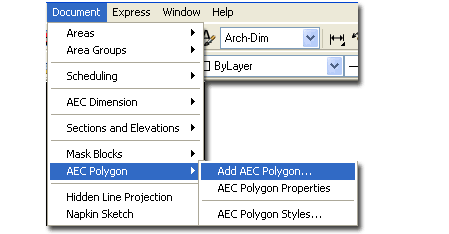 Note: |
||||||||
| 2Adding AEC Polygons | 2-24 POLYGONS | ||||||||
Add AEC Polygon Properties Palette
When Creating AEC Polygons, the Properties Palette offers about as little as it can with four options: Description, Style, Rotation and Elevation. Of the set of options, it is the Style that is the most important since this is what you will need to work with in order to differentiate AEC Polygons. To use, simply start drawing on your screen when the Properties Palette pops up. Think along the lines of drawing with a Polyline that must be Closed in order to work. This Polygon is associated with whatever Style you have set on the Style drop-down list. Description - use this note field to add text based notes about the AEC Polygon if you find that it will help others. You could, for example, explain that the AEC Polygon represents an Existing Park. Style - this drop-down list will, by default, only offer a Standard style but you can easily create your own with the Style Manager ( see below ). These Styles can be used to control the display characteristics of your AEC Polygons and thus really define why you would use AEC Polygons to begin with. One example might be that you want your polygons filled for printing at High Detail but only hatched with diagonal lines when printed at Low Detail. Rotation - not available when Adding AEC Polygons. Elevation - not available when Adding AEC Polygons. |
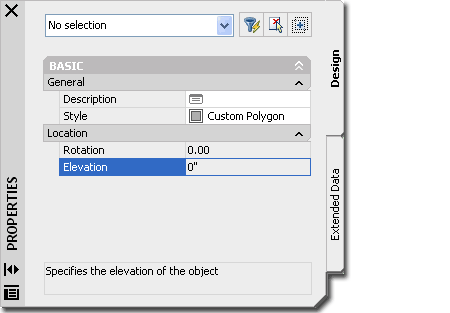 Command Line Option: Close - this is the same close option available for numerous other polygonal objects. You may use it to automatically close your polygon after having drawn two sides or more of a polygon. This is the same as typing "C" on the command line. |
||||||||
Convert to AEC Polygon
Before using the Convert option, make sure to have an AEC Polygon Style defined to your requirements. For Polygons, make sure they are Closed Objects or they will not Convert successfully. Use the Pedit command and the Close option on regular Polygons to Close if there is a problem with the Conversion. Since Profiles tend to be Close Polyline Shapes, they too can be used as a source for creating Aec Polygons. See the [Plines/PRofile] option on the command line when using this command. Profiles that are not created from Closed Polygons will not produce Aec Polygons. |
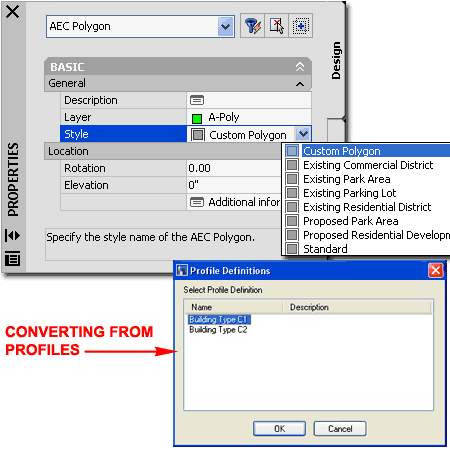 |
||||||||
| 3Modifying AEC Polygons | 3-24 POLYGONS | ||||||||
Modify AEC Polygon dialog box
Illustrated to the right I show the right-click object specific pop up menu and the primary tools it offers access to - see discussions below for more information on each tool. Rotation - use this value field to rotate the Aec Polygon much like using the Rotate command. |
Elevation - use this value field to assign a Z-axis height for 3D work. This is similar to moving the object up or down in Elevation View. Since Aec Polygons are 2D there really is not much of a reason to move them above the Z=0 plane. Be aware however, that these objects do Shade in 3D and can be Rendered so you can use them to mask other objects. Additional information - use this dialog box to check for erroneous coordinate settings such as improper Z-axis values or to set unique position, scale or rotation values. |
||||||||
Divide AEC Polygon
Dividing Area objects is just like Trimming Area objects. The end result produces two unique Area objects that can be Moved apart from each other or edited in other unique ways. |
|
||||||||
Join AEC Polygon
Joining Area objects is much like Joining Space and other objects in ADT. You can select the two or more Area objects to join in any order you want and after the first object has been selected, you can use the Window or Crossing Window method to select the remaining Area objects that you may want to Join to. Be aware that AutoCAD and ADT allow for non-overlapping objects to be Joined mathematically. This means that you can Join two or more Area objects even if they have space between them. If you encounter such a problem, you can use the Divide tool to separate them. |
|
||||||||
Subtract AEC Polygon
Subtracting Area objects is much like Subtracting Space and other objects in ADT. When you Subtract, you must first the select the Area object you wish to keep and then the Area object(s) you wish to subtract from the first object. Be aware that you can subtract non-overlapping objects; the result is that one object usually disappears. |
See image above |
||||||||
Intersect AEC Polygon
Intersecting Area objects is much like Intersecting Space and other objects in ADT. You can select the two or more Area objects to Intersect in any order you want and after the first object has been selected, you can use the Window or Crossing Window method to select the remaining Area objects that you may want to Join. Be aware that you can Intersect non-overlapping objects; the result is that one object usually disappears. |
See image above |
||||||||
Trim AEC Polygon
Trimming AEC Polygon objects is a task less complicated than AutoCAD's Trim command and how it works on Lines, Arcs and Plines. When you Trim AEC Polygon objects, it is assumed that you will maintain a closed polygon shape so all you are asked to specify are the two points that define the edge and angle for the Trim. Unfortunately, that is also how limited this tool is and you cannot Trim to other objects or irregular edges. If you need to perform more advanced Trim-like operations, try working with the Subtraction tool. |
|
||||||||
Add Vertex to AEC Polygon
Adding AEC Polygon Vertices should prove to be fairly easy as long as you expect to make simple changes. Personally, I find that if a lot of Vertex work is required it is often much faster to just recreate the AEC Polygon object. If you are familiar with using Plines in AutoCAD and the Pedit command, you already have the concept down. One of the nice features with Pedit is that you can see your Vertex points as you move the "X" marker from one point to the next. With ADT objects, you do not get that visual aid and thus it can often be frustrating trying to figure out where to locate a new Vertex with respect to existing ones. A trick for visualizing where the vertex points are is illustrated to the right and involves using Grips. As you Insert or Remove Vertex points, you cannot see them and must rely on Osnaps to find them. When you Add a Vertex, you should notice that you actually acquire two Grips: one controls the position of the edge and the other controls the position of the vertex point itself. |
|
||||||||
Remove Vertex of AEC Polygon
Removing AEC Polygon Vertices is just like Adding them but with the added problem of really needing to see where the existing Vertices are. As with Adding, see comments above, Grips can be used as a great visual aid here. |
|
||||||||
| 4AEC Polygon Styles | 4-24 POLYGONS | ||||||||
AEC Polygon Style Manager
For AEC Polygon objects, you can use the Style Manager to load, modify, delete and create new AEC Polygon Styles. Unlike most other Object Styles, there are no predefined Aec Polygon Styles in the Styles folder for ADT but you can obviously create your own should you need one. Illustrated to the right, I show the process of creating a New AEC Polygon Style that I have Named "Custom Polygon". By double-clicking on this new style, you will invoke the AEC Polygon Style Properties dialog box - as illustrated. The General tab provides access to the Name and Description fields for a Style; plus access to the attachment of Notes and Property Sets. You might want to look into the Property Sets option if you want to create a Schedule that can read information from these Aec Polygon Objects.
|
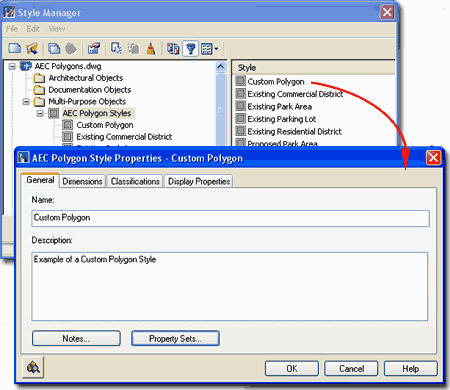 |
||||||||
| Style
Properties - Dimensions tab The Dimensions tab of the AEC Polygon style properties dialog box offers the ability to set an edge width to the polygon and a justification offset value to determine how that width will be set. Edge Width - this value controls how far in a second perimeter line will be positioned relative to the exterior edge and based upon the Justification. This Edge Width provides an option for filling between two perimeter edges with Hatch Patterns. For an extremely thick appearance, you can use the Solid Hatch Pattern. Justify - use this drop-down list to chose between three justification options: In, Center or Out. When an Edge Width has been set, these justification options control how the Width is measured relative to the original perimeter edge. With the Center, for example, the width is equally divided to the Inside and Outside as measured relative to the original perimeter edge. If you run a couple of test and use the Grip marker to see how the edge is shifted, you will quickly see the difference between each option. |
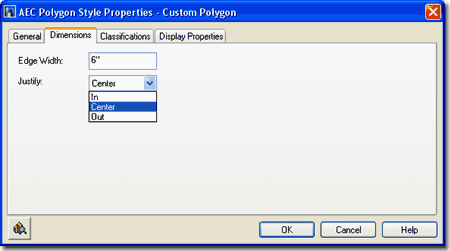 |
||||||||
Style
Properties - Classifications tab
Classifications offer another way to separate Object Styles into categories that can be used in Schedules and even in Display Representation Sets ( as "Show" or "Hide" ). Illustrated to the right I show that I have one Classification Definition ( see Format pull-down menu) with a list of Classification Names or Types. Generally you will not have any options on this Tab but if you have created at least one Classification Style that has been set to "Apply To" Aec Polygon Styles, you will be able to use it here. The range of use is really up to your imagination but it is fairly obvious that Classifications can be quite handy in Schedules. This topic will be discussed further under Part 18 - Schedules. You can also read a bit more about how to create Classification Definitions in Part 1 - Display. |
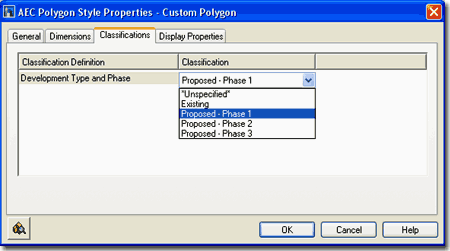 |
||||||||
Style
Properties - Display Props tab
The Display Properties tab of the AEC Polygon Style Properties dialog box provides access to some simple display options. AEC Polygon objects do not have many components so there is a very limited, though useful, set of controls. You should find on the Layer/Color/Linetype tabs of most of the display representations, the option to turn on/off Hatches and Edges - as illustrated below.
|
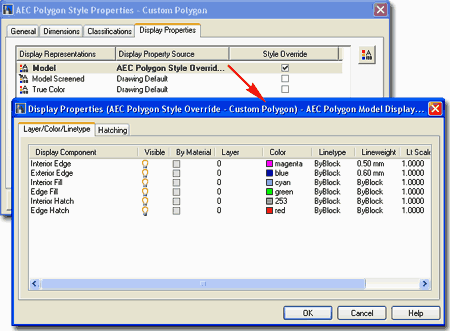 |
||||||||
| 5AEC Polygon - Display Properties | 5-24 POLYGONS | ||||||||
| Entity Properties - Component Layers
From this point, you can not only turn components on or off but change their layer, color and linetype. This is where, for example, you can create AEC Polygons that have solid hatch patterns in unique colors and Edges with unique Linetypes. By default, you only have three Display Configurations to choose from: Model, Model Screened and True Color. Model will display for most Display Configurations while Model Screened will only display under the Screened Display Configuration and True Color will only display under the Presentation Display Configuration. |
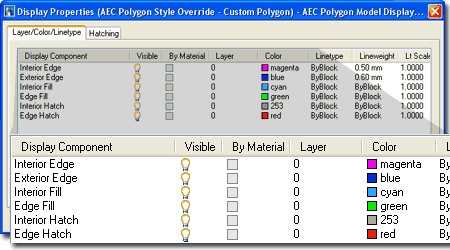 |
||||||||
Entity
Properties - Component Hatching
As with Spaces and Space Planning work, you can change the Pattern for the AEC Polygon objects so they can be read as various shades of Solid colors.
|
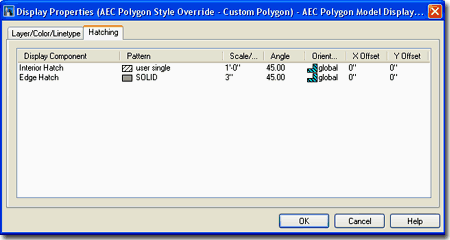 |
||||||||
| Entity Properties -
Component Layers - True Color One unique option that you won't find on other ADT objects, is a True Color Display Representation on the Display Properties tab of the AEC Polygon Style Properties dialog box. Unlike AutoCAD's Hatch Patterns and Layers however, you will not find the expanded Color features that include Pantone Colors. This feature of ADT was apparently not updated. If you double pick on the True Color Display Representation you should will find two Fill Properties for your AEC Polygon. You can choose any True Color for the Edge Fill and/or the Interior Fill ( see image above, left ). To actually see and use the results of these settings is another matter and is probably the reason you are reading this very sentence. I have outlines this subject below. |
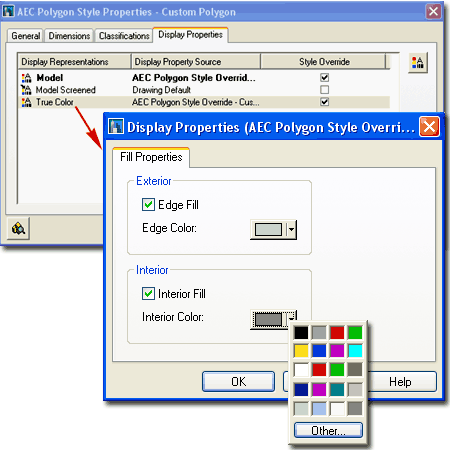 |
||||||||
Entity
Properties - Component Layers - True Color - How to Display
By default in the ADT Template Files, the True Color Display Representation only displays when you set the current Display Configuration to "Presentation" as illustrated to the right. If you are not using the default template files or want to alter when the True Color Display Representation is Displayed, use the Display Manager to make this change. On the Display Manager Window, expand the Representation by Object folder and look for the "AEC Polygon" Object. When you Select the AEC Polygon Object, you should see its Display Representations in the right-hand pane as illustrated above right. To activate the True Color Display Representation for another Display Configuration, look for a Display Set that is used by the current Display Configuration such as Plan. If you are unsure about which Display Set to activate the True Color Display Representation for, read up on Part 1 - AEC Setup - Display. Look for the discussion correlating Display Configurations, Display Sets and Display Representations and you should be able to unravel this mystery. |
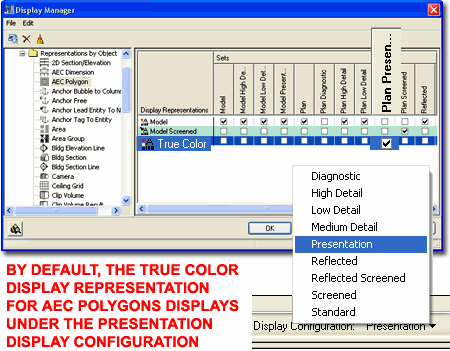 |
||||||||
| 6AEC Polygon - Customizing and Tricks | 6-24 POLYGONS | ||||||||
© Copyright 2001- 2003 ARCHIdigm. All rights reserved.